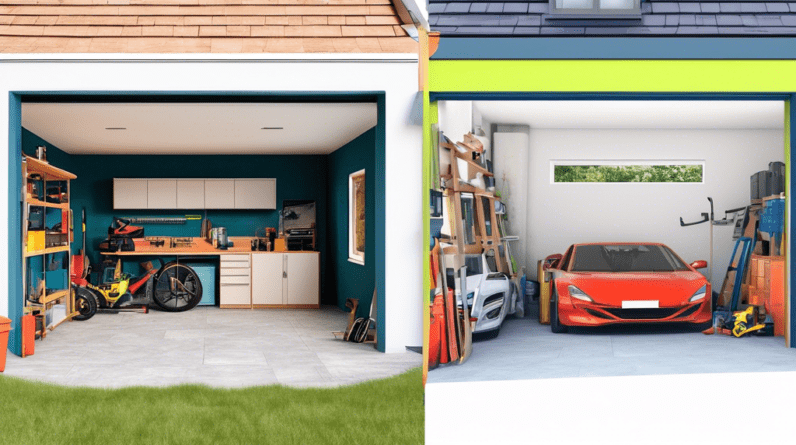
Embarking on a garage conversion is an exciting way to add valuable living space to your home without the upheaval of a full-blown extension. However, like any home renovation project, it requires careful planning and budgeting to avoid unwelcome surprises. Understanding the potential costs involved and employing savvy budgeting strategies can make all the difference in turning your garage conversion dream into a successful reality.
Factors Influencing Your Garage Conversion Cost
Several key factors can influence the overall cost of your garage conversion, transforming a straightforward project into a more complex endeavor. Being aware of these factors from the outset will help you establish a realistic budget:
1. Size and Scope of the Conversion:
The size of your garage is a primary cost determinant. Converting a double garage will naturally cost more than converting a single garage. Similarly, the complexity of your desired living space plays a crucial role. Are you envisioning a basic conversion with minimal changes, or do you aspire to create a luxurious guest suite with a bathroom and kitchenette? The more elaborate your vision, the higher the costs are likely to climb.
2. Structural Requirements:
Garages often lack the structural integrity of a standard living space. Reinforcing the existing foundation, adding support beams, or even modifying the roofline to accommodate insulation and ventilation can significantly impact your budget. It’s essential to consult with a structural engineer to assess the necessary modifications and factor them into your financial plan.
3. Plumbing and Electrical Work:
Extending your home’s existing plumbing and electrical systems into the converted garage is another significant cost consideration. If your conversion includes a bathroom or kitchenette, the costs will be considerably higher due to the need for new plumbing lines, drainage, and specialized electrical wiring for appliances.
4. Insulation and Ventilation:
Garages are typically not built with energy efficiency in mind. To transform your garage into a comfortable living space, you’ll need to invest in adequate insulation for the walls, ceiling, and floor. Additionally, proper ventilation is crucial to prevent moisture buildup and maintain good air quality. These elements are essential for year-round comfort and should be factored into your budget.
5. Flooring, Walls, and Finishes:
The choices you make regarding flooring, wall finishes, and fixtures can significantly influence your overall budget. Opting for high-end materials and custom finishes will naturally increase costs, while selecting more budget-friendly alternatives can help keep expenses in check. It’s all about striking a balance between your desired aesthetic and your financial limitations.
6. Permits and Professional Fees:
Don’t overlook the often-overlooked expenses associated with permits and professional fees. Depending on your location and the complexity of the conversion, you may require building permits, architectural plans, and inspections. Additionally, factoring in fees for contractors, electricians, plumbers, and other professionals is crucial for accurate budgeting.
Tips and Tricks for Budget-Conscious Conversion:
While a garage conversion undoubtedly requires a financial investment, there are several savvy strategies you can employ to maximize your budget without compromising on quality:
1. Plan Meticulously and Prioritize:
Thorough planning is the cornerstone of a successful and budget-friendly conversion. Create a detailed plan outlining your desired outcome, including must-have features and nice-to-have additions. Prioritize your spending by allocating funds to essential structural work, insulation, and utilities first, then consider cosmetic upgrades based on your remaining budget.
2. Explore Cost-Effective Alternatives:
When it comes to materials and finishes, consider cost-effective alternatives that don’t compromise on style or durability. For instance, engineered wood flooring can mimic the look of hardwood at a lower price point. Similarly, choosing prefabricated kitchen or bathroom units can be more budget-friendly than custom-built options.
3. DIY Where Possible:
If you’re handy and have the necessary skills, consider tackling some aspects of the conversion yourself. Painting, installing trim work, or even laying flooring can save you a significant amount on labor costs. However, it’s essential to be realistic about your abilities and leave specialized tasks, such as electrical and plumbing work, to licensed professionals.
4. Shop Around for the Best Deals:
Don’t hesitate to obtain multiple quotes from contractors, suppliers, and subcontractors. This allows you to compare prices, negotiate better deals, and ensure you’re getting the most value for your money. Remember that the cheapest option isn’t always the best; it’s crucial to find a balance between cost and quality.
5. Factor in Contingencies:
Unexpected issues often arise during renovation projects. It’s wise to set aside a contingency fund of at least 10-20% of your overall budget to cover unforeseen expenses. This will provide you with a financial cushion should you encounter unexpected problems, such as hidden structural damage or rising material costs.
6. Communicate Clearly with Contractors:
Maintaining open and transparent communication with your contractors is essential for staying on budget. Regularly review progress, address any concerns promptly, and be clear about your expectations. This will help prevent misunderstandings and costly mistakes down the line.
7. Explore Financing Options:
If you don’t have the funds readily available, several financing options can help make your garage conversion a reality. Home equity loans, personal loans, and even government grants for energy-efficient upgrades are all worth exploring. Carefully compare interest rates, loan terms, and repayment schedules to find the best fit for your financial situation.
Conclusion:
Planning your garage conversion budget requires careful consideration of various factors, from structural requirements to desired finishes. By understanding the potential costs, employing savvy budgeting strategies, and maintaining open communication with contractors, you can transform your garage into a functional and stylish living space without breaking the bank. Remember, a well-planned and executed garage conversion is an investment in your home’s value and your family’s comfort for years to come.






